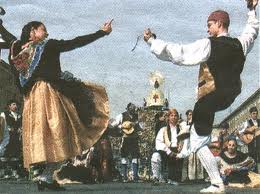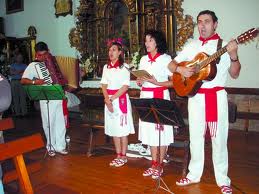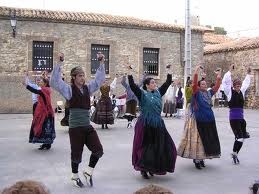Jota
The Jota is a Spanish genre of music and dance that exists throughout Spain, but whose origins lie in the Spanish region of Aragon. However, like most Spanish dances of this time, it varies by region, including a version from Navarra, Galicia and Murcia, among many others.
Jota History

The Jota tends to be in 3/4 metre (although some say that it should be in 6/8) and is both danced and sung. In the Castilian style, the dancers are accompanied by guitars, bandurrias (which is like a mandolin), lutes, a dulzaina (similar to an oboe) and drums. The Galician form of the dance uses Galician style bagpipes, drums and bombos (a type of drum) as an accompaniment to the dance.
The Jota dancers tend to wear regional costumes while dancing, and sometimes castanets. However this is not always the case in less formal settings. The dance steps used in the Spanish dance Jota resemble those of a Waltz, yet there is a lot more variation.
Jota songs can be about a wide variety of different subjects, from religious themes, to patriotic feelings to relationships. The lyrics are sung in quartets of octosyllabic lines. The first and third lines tend to contain an assonantal rhyme.

The Spanish Jota has been used by many classical composers in their works: Franz Liszt wrote a Jota for solo piano; Georges Bizet included a Jota in his famous opera, Carmen; and Mikhail Glinka created his own style of Jota, derived from the Spanish version in his work, 'The Aragonese Jota', which he had studied on a trip to Spain.
The Jota can be split into many different derivations. Here we will look at the Aragonese Jota, the Castilian Jota and the Jota from the Philippines.
The Aragonese Jota is the most celebrated form of folkloric expression today. It can be dated back to the 18th Century, however the 19th Century was the time went the Jota flourished. The Aragonese Jota has undergone some evolution as some of the steps can be quite complicated. From the end of the 19th Century, many choreographed versions of the Jota were produced for films, festivals and competitions. The places to study this Spanish dance in its purist forms include Calanda, Andorra and Zaragoza. Today, there are many new, modern versions of the Aragonese Jota which are performed by different folkloric groups. The most popular include the Jota Vieja and Aragón Tierra Bravía.
The Castilian Jota is the Jota in which guitars, bandurrias, lutes, dulzainas and drums are used. This version is much more sober than its counterparts, even though the steps tend to be quicker and sharper. Despite it being a less airy version of the Jota, the songs for the Castilian Jota are often quite ironic and funny. The songs deals with issues like weddings, love, life and religion.

The Jota became very popular in the Philippines during the Spanish colonial period. The Filipinos imitated the Spanish men and women who would dance the Spanish Jota at weddings and other festivals, and therefore ended up with their own Jota that combines Philippine dance steps with Spanish dance steps.
In the Philippine version of the Spanish dance, they play the bandurria, guitar, bass, other lute style instruments, and unstrung bamboo castanets. In the dance, the women wave their Philippine shawls around while the men keep up the rhythm on the bamboo castanets. The music tends to switch between fast and slow tempos.
The Philippines even has its own regional variations, just like Spain. The Jota Paragua is one example, coming from Palawan’s old capital, Cuyo Islands. This dance contains many typically Spanish elements including the footwork, the shape of the dancers' arms and the frilly dress. Other regional variations in the Philippines include the Jota Caviteña from Cavite and the Jota Manileña from Manila.
